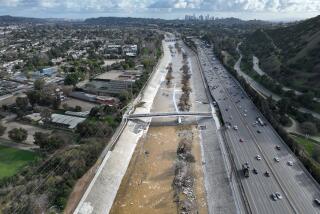Bracing for the Storms
Although the rivers in Los Angeles County manage barely a trickle in the summer, during the winter, rain can turn them into torrents.
Designed by the U.S. Army Corps of Engineers to quickly move water safely to the ocean, they can become death traps.
Water in concrete channels can travel as fast as 25 mph and is often laced with rocks, branches and other debris. During the winter, water temperatures in the Los Angeles Riveraverage about 50 degrees.
Falling in is easy, getting out, nearly impossible.
An average of six people drown each year in the county’s 600 miles of flood control channels.
Because of the dangers, agencies throughout the county practice coordinating their swift-water rescue techniques.
“If we have a victim in the water, the victim can go through three or four jurisdictions, we can all deal with the same victim,” said Los Angeles Fire Department Capt. Don Roy.
“As a victim moves downstream, and we try to pick them out, we’re thinking on the same page, using the same water techniques and same signals so we can communicate together.” For two days in October, Los Angeles County fire and law enforcement agencies trained on the San Gabriel River in Azusa Canyon. They plucked team members from the water in simulated rescues using boats, helicopters and tension lines.
Fire departments from Pasadena, Long Beach, Glendale and Los Angeles join county rescue workers to form the Los Angeles Multi-Agency Swift Water Rescue Task Force. The team is equipped with protective suits and jet skis.
Although the team practices each fall, Roy said the training this year may be a little more intense because of the threat of El Nino.
The task force began in 1992, following the death of Adam Bischoff, 15, of Woodland Hills. Adam was riding his bike along a flood control channel when he was swept into the river. Television cameras captured the horror of the boy calling for help as police and fire officials were unable to rescue him.
Afterward, the Los Angeles City Council and the County Board of Supervisors ordered the swift-water rescue team to be created.
More to Read
Sign up for Essential California
The most important California stories and recommendations in your inbox every morning.
You may occasionally receive promotional content from the Los Angeles Times.










